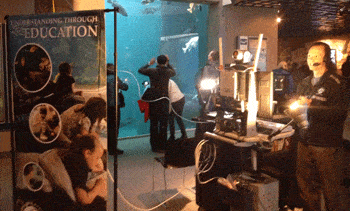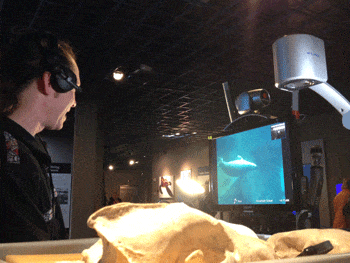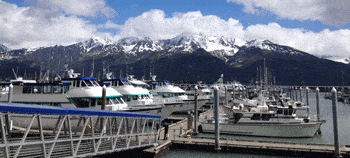After a visiting the Alaska Zoo the Churchill Fellowship continued down to Seward to visit the Alaska Sealife Centre. Set on the edge of town on the shores of Resurrection Bay, the Alaska Sealife Center specialises in cold water marine animals and is Alaska’s only permanent marine mammal rehabilitation facility. Since commencing video conferencing in 2005 the center has grown a reputation of strong content mixed with solid teaching pedagogy. A highly popular place with tourists, my morning visit was timed perfectly with tour groups arriving from the nearby cruise ship!

Presenting marine science via video conferencing
On entering the Center I immediately headed upstairs to meet Darin Trobaugh, a distance education specialist getting ready to run a video conference on Marine Mammals and their Adaptations to some year 4 students on Long Island. We quickly got to work, taking two movable trolleys with distance learning equipment into position at a location that had direct line of sight to a Harbor Seal tank, a Steller Sealion Tank, a marine diving bird tank and a television showing a live feed of a Steller Sea Lion colony on a rocky outcropping on Chiswell Island 35 miles away. This was an interesting video conference for me, not only was the content engaging but it was great to see how Darin handled both the offsite classroom as well as working with the interested public onlookers passing by. To handle the noise within the auditorium Darin used a highly effective headset microphone and ear pieces, similar to those used by sports broadcasters.

Discussing Harbor Seals to students from Long Island
The lesson itself was highly interactive with the students. It combined a variety of mediums; live shots from the holding tanks, document camera shots of otter teeth and fur, recorded footage of animal behaviours and student creating models of seals in their room using simple craft materials. Throughout the session the kids were highly engaged and enjoyed interacting not just with the lesson itself but connected on a personal level with Darin, sharing stories about sea kayaking with whales to living near New York. This again highlighted the real strength of educational video conferencing; it is a two-way conversation in real time with a site that students may not ever get to see in person. Not only is it just about a site’s particular content, the educators who run distance lessons have had real experiences with working in the museum/galleries/zoo/aquarium that they are representing. There is a depth of knowledge that students can access just like the expert was in their own classroom, with the lesson changing to fit the questions of the students as what would occur in dynamic classrooms around the globe.
Of course, once the conference was over it was time to roam the site to check out all the exhibits. One of the interesting sections was the quarantine area whereby injured or newly rescued marine animals spend time to be rehabilitated or checked for disease. In the future this area may well have a dedicated camera installed so that remote students can get up close to this section of the Center. As with many education centres there is a strong take home environmental message for visitors. A poignant section was that of the Exxon Valdez oil disaster of March 23, 1989 which still affects ecology along the Alaskan coastline to this day.

Boat marina in Seward, Alaska
I have thoroughly the Alaskan leg of my fellowship study tour. Great people up here plus it is really hard to take your eyes off the mountains and glaciers as you go about the place! I was able to spend some time off checking out Exit Glacier and the townships of Talkeetna and the Whittier. The next leg of this journey will take me off to Indianapolis to visit the heart of North America video conferencing at the Center for Interactive Learning and Collaboration offices. Whilst there I’ll spend some time at the Nina Mason Pulliam Ecolab and check out the world’s largest Children’s Museum not far from downtown. Lots more to do!























Comments